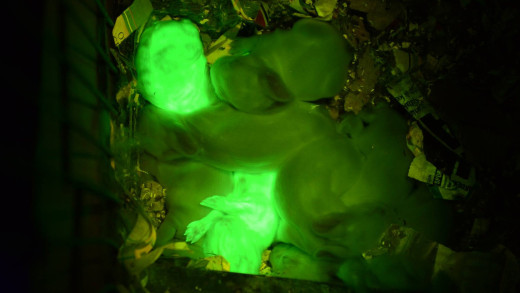HAWAII – As Hawaii Island sits embroiled in a passionate debate over genetically modified organisms and their place in local agriculture, the Universty of Hawaii – Manoa has issued a media release proudly announcing that “glowing green rabbits” have been born using the medical school’s highly successful transgenic technique.
The birth happened in Turkey, but the release says the scientists used “an active transgenesis technique founded by medical researchers at the University of Hawai`i Mānoa.” UH says the ultimate goal is to produce lower-cost medicines for humans.
With the release – as advertised – comes international footage of a few glowing rabbits, nestled among their newborn siblings.
From the University of Hawaii – Manoa:
| Using an active transgenesis technique founded by medical researchers at the University of Hawai`i Mānoa, scientists in Turkey have produced glowing green rabbits. This is the first time the UH technique has been used to produce rabbits.The transgenic rabbits were born last week at a university in Istanbul. In normal lighting, they look just like their furry, white rabbit siblings. But when exposed to black light, the pair of transgenic bunnies shines a vivid shade of green.The glowing effect is the result of a fluorescent protein from jellyfish DNA, which was injected into the mother rabbit’s embryo in the lab. The altered embryos were re-inserted into the mother rabbit, and when the litter of eight was born, two of the rabbits carried the “glowing gene.” That is a higher percentage rate than previously achieved in rabbits.
The point of the experiment was to show that genetic manipulation with the University of Hawai`i’s technique works efficiently in rabbits. The overall goal is to introduce a beneficial gene into female rabbits, then to collect the protein made in the milk produced by the female rabbits. This approach could lead to new and competitively efficient ways to produce medicines. The Turkish success was collaboration between two universities in Turkey and the UHM Institute for Biogenesis Research (IBR) at the John A. Burns School of Medicine (JABSOM). The background of project rabbit Emeritus Professor Ryuzo Yanagimachi and Associate Professor Stefan Moisyadi travelled to Istanbul in November 2011 to set up the collaboration. Yanagimachi, the founder of the IBR, is recognized around the world as the scientist whose early work with animals laid the foundation for the development of in vitro fertilization in humans. Dr. Yanagimachi also invented a laboratory technique for inserting sperm into an egg, a method that is now used in fertility clinics everywhere. Dr. Yanagimachi produced the world’s first cloned mouse and was the first to use his sperm injection technique to produce transgenic mice. To assist with hands-on teaching of the technique, Dr. Moisyadi returned to Istanbul this past June with IBR Transgenic Facility Director Dr. Joel Marh. (Hawai`i public school shoutout–Dr. Marh graduated from Roosevelt High School). Giddy reactions in the rabbits’ new “home town” What’s Next? The Institute for Biogenesis Research at JABSOM is the home of high-level reproductive research. It is located within the medical school’s department of Anatomy, Biochemistry and Physiology. Its goals include continuing to improve human in vitro fertilization techniques |


by Big Island Video News12:00 pm
on at
STORY SUMMARY
HAWAII – As Hawaii Island sits embroiled in a passionate debate over genetically modified organisms and their place in local agriculture, the Universty of Hawaii – Manoa has issued a media release proudly announcing that “glowing green rabbits” have been born using the medical school’s highly successful transgenic technique. The birth happened in Turkey, but […]